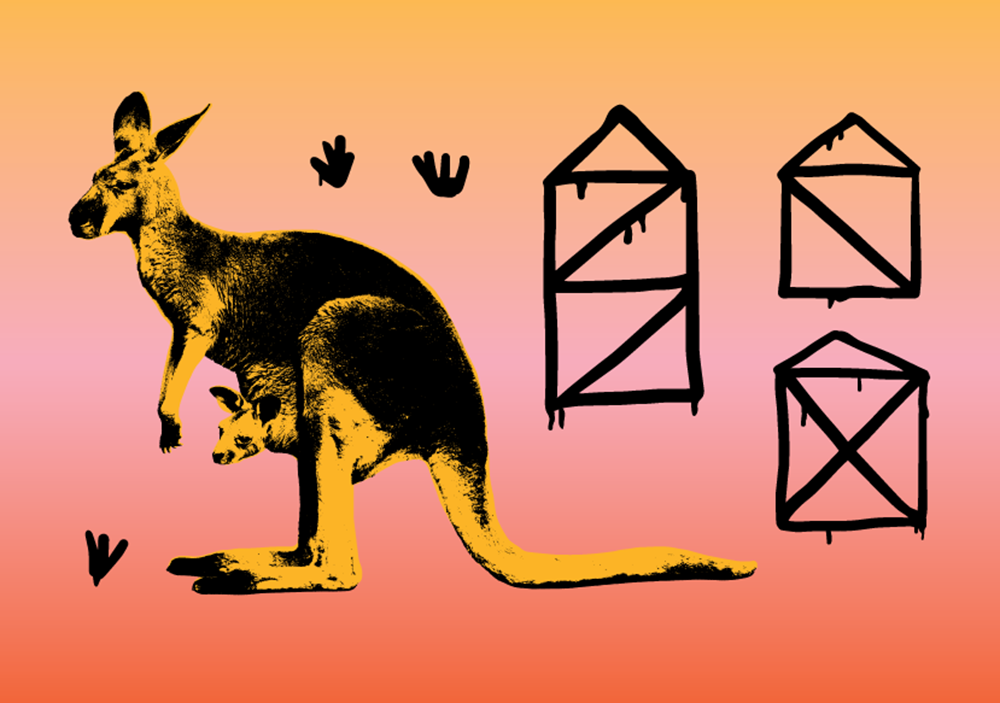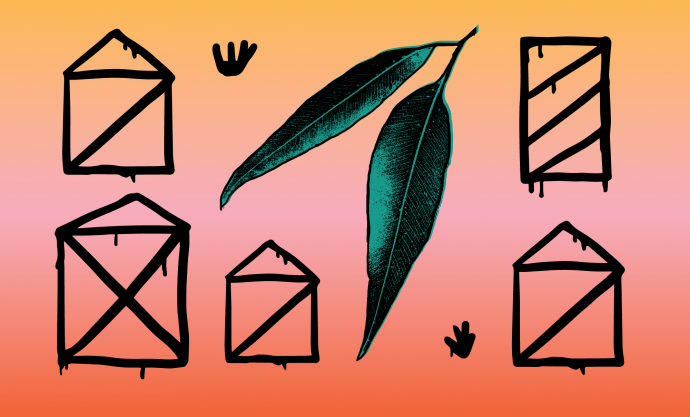Libby Porter on unlearning planning practice

Since her childhood, a sense of the unknown has fuelled Libby Porter’s desire to challenge established modes of thinking. In primary school, she remembered wondering about the one Aboriginal boy in her class. Why had she never been taught anything about his culture? Why was pre-colonial history so little discussed? She began to imagine what Australia was like before white people arrived. As a teenager, an opportunity to volunteer with the Cherbourg Aboriginal community in South East Queensland began to fill the gaps in her education, giving her insights into the wisdom held by Aboriginal people. These learnings stayed with her and formed the basis of an ongoing investigation into the invisibility of Aboriginal culture in planning systems. Now an associate professor at RMIT’s Centre for Urban Studies, Libby’s work continues to position Aboriginal knowledge, people and culture at the heart of planning and urban development. Timmah Ball sits down with Libby to talk about a new vision of planning practice, in which Anglo-paradigms and Aboriginal identities can coexist.

Timmah Ball: I recently came across this quote in the Griffith Review from Aboriginal author Bruce Pascoe that really moved me:
“European science has produced marvels and its foundation principle is curiosity. Why are we not curious that Aboriginal people could cultivate crops in the desert? Why do we pay no attention to the dams and irrigation techniques employed? Why do we not investigate the crops and farming techniques developed over thousands of years to accommodate the challenging characteristics of this continent?”
Are there ways that planning systems and environmental policies can use Aboriginal knowledge?
Libby Porter: When I first started working with the Wadi Wadi people in Swan Hill during my PhD, I started from the foundation of inclusion. I was aware that the planning system did little to support Aboriginal people, particularly around land rights, and I wanted address this. While working with the community, I was trying to find ways to include their knowledge, practise and ideologies in planning schemes and other ‘official’ government processes. But then I started to feel that this wasn’t enough. I didn’t feel comfortable taking from another culture. It felt like there needed to be a shared vision rather than pulling ideas from Aboriginal people when it seemed appropriate.
From this perspective, it’s about removing the power and authority of Anglo discourse and accepting that there are actually other systems of thought in Australia. We need to understand and value all cultures. So it’s not just about including Indigenous perspectives, but about creating a hybrid model where Aboriginal knowledge and planning practice co-exist. Rather than finding ways to use Aboriginal knowledge when it suits us, we will value this system as equal and find ways for both knowledge systems to work together. This isn’t easy and it will require planners and governments to acknowledge the system’s complicity in the dispossession of Aboriginal people from their land. This is a long-term vision. And sometimes, major change takes generations.
TB: At the 2015 Melbourne Writers Festival, Tony Birch spoke about Aboriginal knowledge and climate change. He talked about his commitment to his children and the struggles of his mother and grandmother to find food. Were these stories part of the larger narrative of climate change? Yes, he concluded. How can we create spaces where these perspectives are valued, where binaries such as science/culture collapse? And are there ways that cultural ecologies could exist in rigid systems like planning schemes and legislation?
LP: In many ways, Aboriginal people are still coming to terms with what happened to them and how their country changed after white settlement. But we all know they are still here and largely thriving, despite all odds. As Tony Birch mentions, there are many amazing stories of survival that the rest of Australia can learn from. The strength and resilience of Aboriginal communities is something we can draw from when we begin to confront issues like climate change.
Unfortunately when you think about Western science and the dominant frameworks that structure how we live, there is little appreciation for other philosophies. We know they exist on the margins, but they are not taken seriously. In planning, there seems to be a professional myopia against non-traditional ways to develop cities. People want to maintain the discourse they feel comfortable working within. This tends to be a technocratic approach – we are often completely silent about cultural ecologies and other perceptions of place.
But I love the ideas Tony [Birch] brings. This sort of knowledge is passed on orally, through family and of course storytelling. It refers to intergenerational sources and is evidenced not in relation to empirical inquiry but in relation to custodial responsibilities, narrative, and spiritual awareness. These stories of love and commitment to family and country are vital. But since planning values ‘certainty of fact’, these histories are often rejected. This will change when we re-examine the overarching authority of Eurocentric culture. But it will take time.

TB: Artists such as Reko Rennie are doing amazing work that celebrates contemporary Aboriginal culture in cities. It almost feels like the best achievements might come from radical and informal urban interventions rather than planning and policy. What do you think?
LP: Yes, absolutely, you’re right. I gave a talk recently and actually finished with a slide of a Reko Rennie mural. His work is bright, arresting and forces you to think. In comparison, planning systems are slow and impenetrable – for most people, it’s like another language that doesn’t offer easy ways to think about how they can change and influence cities. So it’s much easier to just do things yourself. We can see this in the increasing popularity of guerrilla-style interventions and tactical urbanism.
I’m not sure if this is enough. We need to foster a new generation of planners and thinkers and encourage them to move beyond standard practice and conventional careers. It often feels like I am the only one, and people are sick of hearing my voice. I want more built environment professionals to take responsibility, to take risks and make positive changes. What artists do is often the most exciting and experimental. So I agree with you, but feel other people need to take action as well.
TB: You’ve done a lot of work in Canada. Can you tell me some of the ways you’ve witnessed First Nation people find opportunities within planning legislation and frameworks? How can Australia learn from this?
LP: It’s interesting because whenever I’m in Canada, people are excited to hear what’s happening in Australia. But I think we can always look to what other people are doing with hope. And you are right: there are many things we can learn. To begin with, Canada’s planning education programs have changed radically. There are now whole programs in Indigenous planning – the entire content focuses on First Nation people’s understanding of planning and caring for urban and regional environments. It’s amazing that we don’t do this here. It goes without saying that it is something we should aspire to do. Changing our approach to teaching would be an incredible opportunity to create a major shift in the next generation of planners.
The research I have done in British Columbia explored how the Gitanyow First Nations in the Nass and Skeena region developed a positive partnership approach and working relationships with government bodies. It moved away from thinking that an Aboriginal heritage act is enough, or that including Aboriginal knowledge at various planning stages will suffice. There was an acknowledgement that two different systems were operating at once: the Canadian governing or legislative powers, and the Gitanyow people’s plan and sovereignty. Rather than competing, it was about co-existence. It was a slow process, but over time the Gitanyow Plan came to have authority as a planning document. This meant that the Gitanyow people have much greater control over their territory.
I think this shows the power of community planning. Communities have the skills and intimate knowledge to make successful plans – this is what the Gitanyow people have done. Local people are best placed to make decisions about the future of their environment. There are so many cultural layers and stories of place that a professional can easily miss or even disregard when making decisions. I believe plans made by communities need to be treated with the same authority and respect as planning frameworks and regulation.
We end the conversation with the sense that there is much work to do – and that we are just at the beginning. As cities and communities globally face hostile challenges such as climate change, the development of new frameworks that build on cultural ecologies and Indigenous knowledge is an important place to start. And it is reassuring that there are leading lights, such as Libby, who are willing to take bold steps in this direction.
A big thank you to Libby for taking the time to talk to us about her important work, to Timmah Ball as always for her insightful questions and ideas, and to Alice Oehr for the accompanying illustrations. Timmah wrote two thought-provoking articles for us last year, Last Stone Left: Wellbeing and Aboriginal placemaking in the city, reflecting on cities as sites of cultural significance, and Remember Me: Architecture, placemaking and Aboriginal identity, where she shares her views on ‘Portrait’, the ARM Architecture-designed William Barak apartment building.